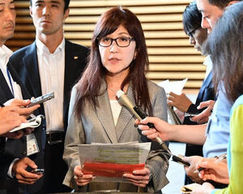 Source: www.matome.naver.jp
Source: www.matome.naver.jp The incumbent mayor of Tokyo, Koike Yuriko, herself a former member of the LDP and leader of the Residents First Party, is currently leading in popularity polls as a result of her exposes of wasted public funds during the LDP’s tenure in city government and the knock-on effect from the criticisms directed at LDP party leader and PM Shinzo Abe’s links to educational institutions espousing right-wing ideologies and which appear to have received favoritism for funding school building projects.
The combined LDP-Komeito majority in both the Upper and Lower Houses of the Diet ensured that any further debate on these links ceased with the closing of the current Parliamentary session last week, and so far there has been no indication that the government intends to placate the opposition parties by convening a special session of Parliament to examine the links in greater detail.
These issues, along with the government’s decision to ram anti-conspiracy legislation through the Diet (legislation that itself had attracted criticism from the UN for its overly broad application and potential for misuse), has thus made the LDP nervous about Tokyo residents might do to its fortunes in the up-coming election. A re-election of Koike would weaken the LDP’s already tenuous hold over major cities in Japan, and that could then have repercussions at a national level should the Residents First Party expand to other parts of the nation. Hence for Defence Minister Inada to make her rather ill-judged appeal during campaigning could not come at a worse time for city LDP planners.
Realizing her mistake, late on Monday evening Minister Inada attempted to make amends for her remarks, however by that stage they had been seized upon by both the media and opposition parties who immediately began calling for her to either resign or be removed from office. The LDP-Komeito dominance of the Diet makes this highly unlikely, and words to that effect were made by Chief Cabinet Secretary Suga on Wednesday who foresaw no need to have Minister Inada step down and urged her to concentrate on her work. Yet members of the LDP standing for election were less sanguine in their comments concerning Inada’s behavior, describing it in blunt terms as “stupid”.
Inada’s history of making verbal gaffes, and her strident displays of nationalism would ordinarily lead to either a censure or possible demotion, yet in the current political climate in Japan her position is safe so long as the LDP suffers no ill-effects at the national level. With the Komeito already distancing itself from the LDP in the Tokyo mayoral election, the LDP will need to regain public trust in its judgment and its willingness to confront awkward questions related to its finances and influence. With voting set to kick off on Sunday, the LDP will be hoping that it can weather some the blowback from its recent scandals, although its prospects at the moment do not look too bright.
 RSS Feed
RSS Feed